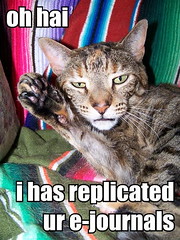
Speaker: Anne Kenney, University Librarian, Cornell University
30 years ago when NASIG began, we wouldn’t have been worrying about the preservation of ejournals. But we do. The digital-first ecology disrupts traditional roles and responsibilities, with publishers now being responsible for preserving the journal content rather than libraries. We’re still trying to figure out how to manage the preservation and access.
60% of Cornell’s collections expenditures goes to online resources. An Ithaka survey shows that most institution types spend more on online and ongoing resources than on any other collection format. The same survey found that Doctoral institutions are far more interested in preservation of online materials than Masters and Baccalaureate schools.
A study of library directors identified several issues for libraries:
- sense of urgency
- need for trusted independent archiving
- content coverage and access conditions
- resource commitment and competing priorities
- need for collective response
There was a need for a non-profit preservation program separate from publisher projects, with a focus on scholarly journals. Portico, Scholar’s Portal, and CLOCKSS are the three main programs still existing that meet the needs of ejournal preservation. They are being supported to varying degrees by ARLs.
The coverage in these three programs is uneven and it’s difficult to create a definitive list. The major publishers are represented, and there is significant duplication across the services. She’s not losing sleep over the preservation of Elsevier journals, for example. STM literature in English is very well preserved.
The Keepers Registry attempts to gather and maintain digital content information from repositories archiving ejournals. KBART could be useful for keeping this data clean and updated.
2CUL did a study in 2011 to see how well their content was being preserved in LOCKSS and/or Portico, and only 13-16% of their titles were preserved. Most are those that have ISSNs or eISSNs, which is only about half of the titles held by the schools. They expanded to include Duke in 2012 and looked at all the preservation sources in the Keepers Registry. Only 23-27% of the ejournals with e/ISSNs were preserved, and there was considerable redundancy across the preservation programs.
Vulnerable content that is not being preserved well includes third-party content, aggregator content, small publishers, open access titles, and historical publications. They are looking to create some best practices for OA journal preservation.
The preservation programs need better coordination to identify what redundancy is necessary and how to incorporate more unique content. Right now, they see themselves more as competitors than collaborators, and that needs to change.
All of the scholarly record must be preserved, and it’s the responsibility of everyone in the scholarly communication world, not just libraries. Much of the content is at risk and no one can do this alone. No single archiving program will meet all needs, and they need more transparency and cooperation. License terms are inadequate for most preservation needs, and maybe we need legislation to cover legal deposits. We need clearer and broader triggers for when we can access the preserved content (there is a concern for the long-term financial sustainability of a dark archive).
Libraries need to acknowledge this is a shared responsibility, regardless of size and type of library. Publishers are not the enemies in this domain. Participate in at least one initiative. Move beyond a registry of archived publications to identify at-risk materials critical to scholarship.
Publishers need to enter into relationships with one or more ejournal archiving programs. Provide adequate information and data to archivers on coverage. Extend liberal archiving rights in license agreements, and consider new terms for access.
Archiving programs need to expand coverage to include vulnerable materials. Be explicit about coverage, and secure access rights.
NASIG can raise awareness of this issue. Endorse power of collective action. Consider a set of principles and actions, such as the KBART standard and revising SERU to include better terms for archiving. Foment international cooperation with other organizations and funding bodies.




